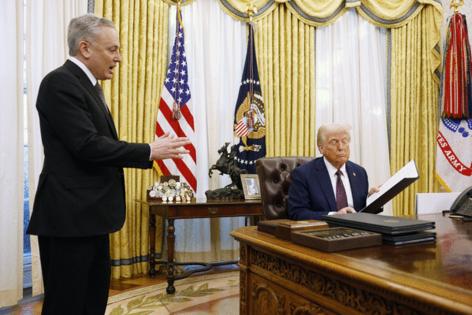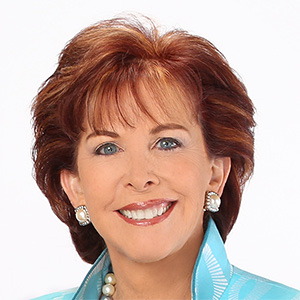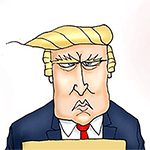Trump urges looser rules, wider energy access in AI policy plan
Published in Business News
The Trump administration called for boosting artificial intelligence development in the U.S. by loosening regulations and expanding energy supply for data centers under new guidelines that also urged withholding funds from states that put burdensome rules on the emerging technology.
The so-called AI Action Plan, released by the White House on Wednesday, recommends revamping the permitting process and streamlining environmental standards to speed AI-related infrastructure projects. The blueprint also seeks to make American technology the foundation for AI worldwide while enacting security measures to keep adversaries like China from gaining an edge.
“It is a national security imperative for the United States to achieve and maintain unquestioned and unchallenged global technological dominance,” President Donald Trump said in the report. “To secure our future, we must harness the full power of American innovation.”
Mandated by Trump shortly after taking office in January, the 23-page plan marks the administration’s most significant policy directive on a technology that promises to reshape the global economy. The president is scheduled later Wednesday to speak at an AI event hosted by the All-In Podcast and a consortium of tech leaders and lawmakers known as the Hill and Valley Forum.
Trump plans to sign a handful of executive orders Wednesday to set in motion elements of his AI plan. The expected directives include a plan to use the U.S. International Development Finance Corporation and the Export-Import Bank to support global deployment of American technology. Another would call for all large language models procured by the government to be neutral and unbiased.
The blueprint represents the culmination of Trump’s campaign promise to position America as the world leader in AI, while dismantling what he characterized as a rules-heavy approach under President Joe Biden. Trump rescinded a 2023 order from Biden that had set extensive safety testing requirements and mandated transparency reports from major AI developers. In its place, Trump demanded a new path on AI policy and set a six-month deadline for White House AI czar David Sacks to create it.
Sacks, a venture capitalist who has emerged as one of the administration’s most influential voices on tech policy, was joined in shaping the new policy approach by senior AI adviser Sriram Krishnan and tech policy chief Michael Kratsios. Together, they spent months cultivating detailed input from key AI companies and other industry leaders.
Regulatory rollback
Under the recommendations, the federal government would ask businesses and the public about existing regulations that hinder AI adoption, with an eye toward rolling back those rules. The White House’s budget office would also work with federal agencies that have oversee AI-related funding to consider putting limts on those awards “if the state’s AI regulatory regimes may hinder the effectiveness of that funding.”
The guidelines also call on the federal government to only contract with developers whose AI models are deemed “free from top-down ideological bias” and strip references to misinformation, diversity and equity language, and climate change from risk-management frameworks.
“To win the AI race, the U.S. must lead in innovation, infrastructure, and global partnerships,” Sacks said in a statement. “At the same time, we must center American workers and avoid Orwellian uses of AI.”
The White House, signaling concern that AI could reshape the labor market, also asks the Education and Labor departments to prioritize skill development and training to assist U.S. workers. It also proposes prioritizing investment in theoretical, computational, and experimental research — a request that comes even as the administration has slashed grants to top-tier research universities.
Race with China
The blueprint suggests countering Chinese AI development by strengthening export controls, including by putting new location verification features in advanced AI chips. The administration also wants to establish a new effort under the Commerce Department to collaborate with the intelligence community to monitor AI developments and chip export control enforcement.
The plan also envisions the Commerce Department gathering proposals from the industry on full-stack AI export packages that would allow approved allies to purchase hardware, software, models and applications together. Approved deals would be facilitated by the U.S. Trade and Development Agency, the Export-Import Bank, the U.S. International Development Finance Corporation, among others.
The guidelines were released a little more than a week after the administration moved to ease restrictions it had imposed in April barring Nvidia Corp. and Advanced Micro Devices Inc. from selling some AI chips to customers in China. The export curbs were relaxed as part of the trade understanding reached with China in June in exchange for Beijing resuming shipments of rare earths to American buyers.
Sacks and Commerce Secretary Howard Lutnick have defended the move, saying that letting Nvidia restart shipments of its H20 chips would position the U.S. to compete more effectively abroad and blunt efforts by Chinese tech giant Huawei Technologies Co. to gain a bigger slice of the global market.
“These clear-cut policy goals set expectations for the Federal Government to ensure America sets the technological gold standard worldwide, and that the world continues to run on American technology,” said Secretary of State Marco Rubio in a statement.
Energy components
Trump and other administration officials have also stressed the importance of meeting another tech industry priority: ensuring the U.S. has enough power to run energy-hungry AI data centers. In their view, adequate electricity supply is intertwined with national security, essential to keeping the U.S. ahead of global competitors in the race to dominate artificial intelligence.
The plan recommends working to stabilize the existing energy grid and implementing strategies to enhance the performance of the transmission systems. The document also suggests prioritizing the interconnection of reliable, detachable power sources that could see nuclear and enhanced geothermal plants deployed to help manage a surge in demand.
©2025 Bloomberg L.P. Visit bloomberg.com. Distributed by Tribune Content Agency, LLC.












Comments